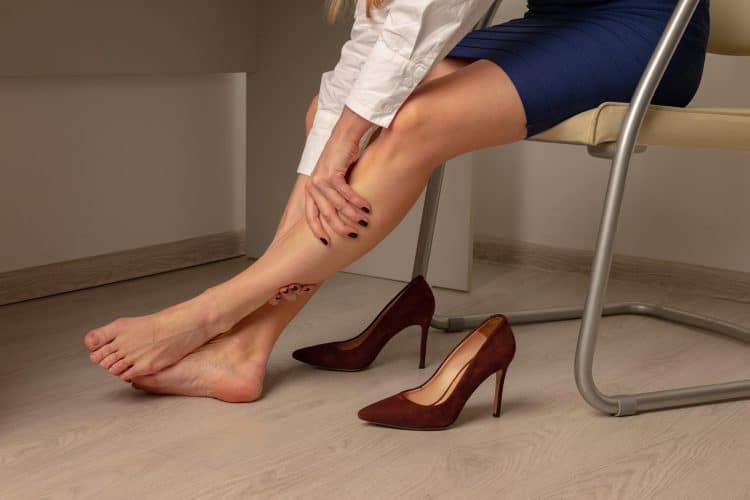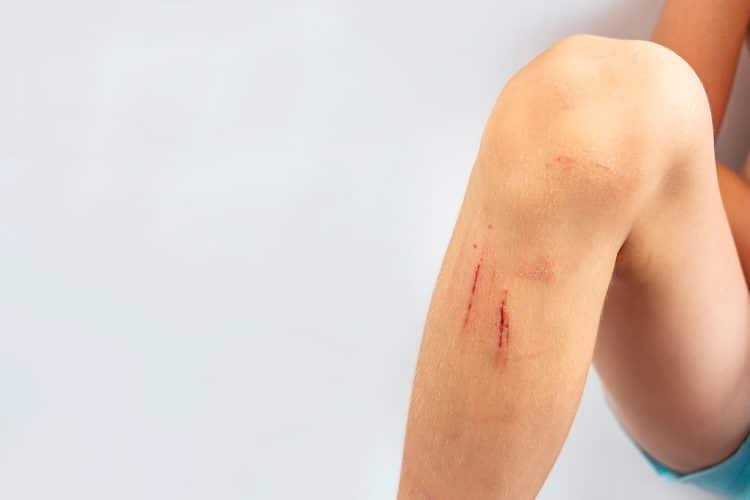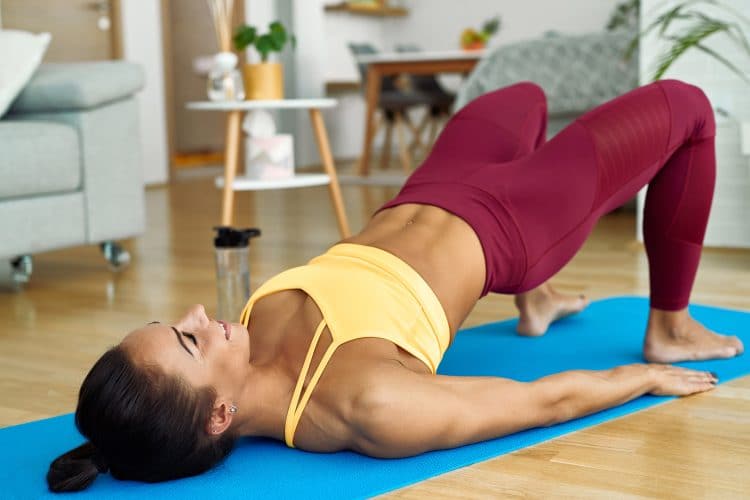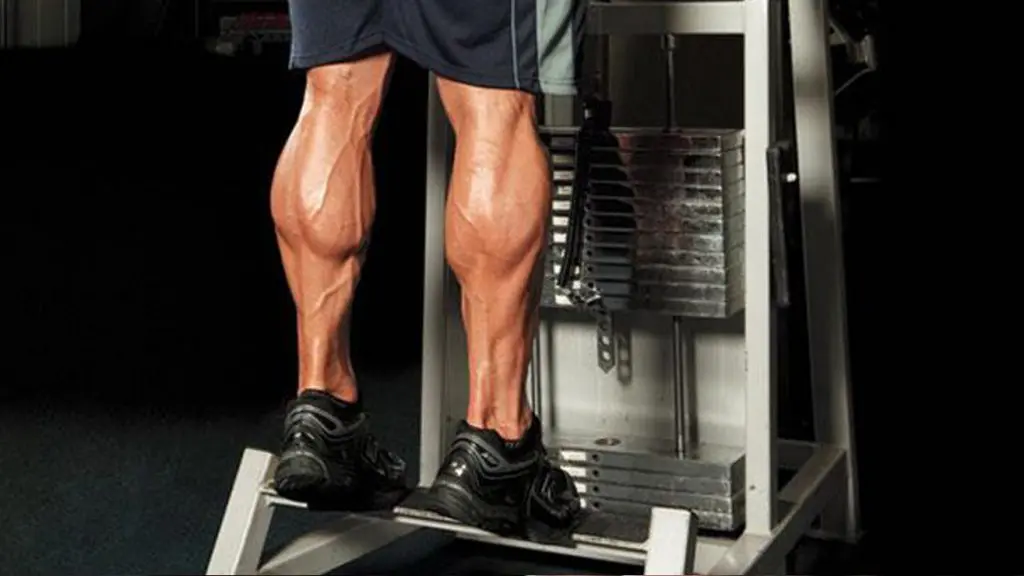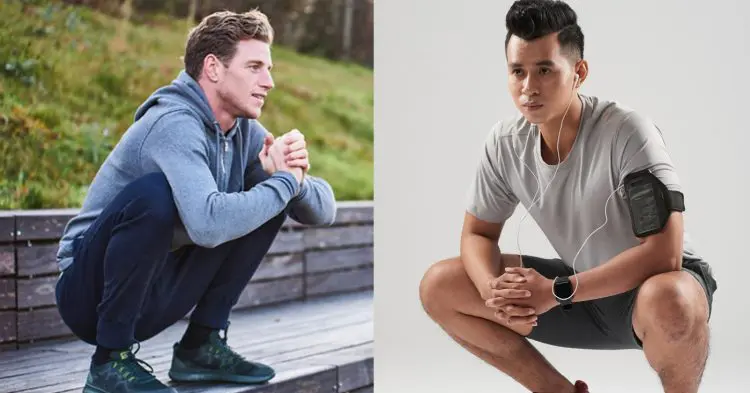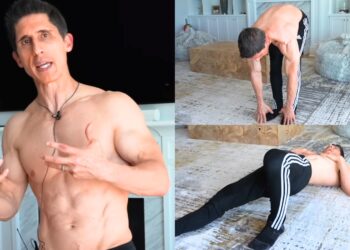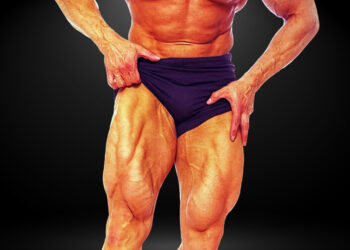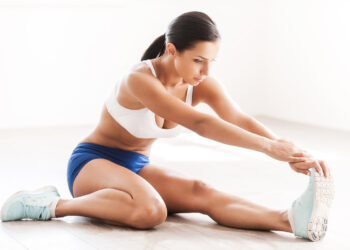Leg pain is a common problem that many of us experience at some point in our lives. It can range from mild to severe, annoying to debilitating. Often sticking out of the blue, leg pain can make walking, running, exercising, and even sitting very uncomfortable. It may even stop you from getting around easily.
The good news is that, in some cases, exercises and stretches can help alleviate your symptoms. This is especially true if you’ve been overdoing it, have a mild injury, or have been sitting at your desk for too long.
In this guide, we discuss some of the most common causes of leg pain and share a range of effective exercises and stretches to ease your leg discomfort. So, say goodbye to nagging leg pain and discover a healthier, drug-free approach to finding relief.
What Are the Causes of Leg Pain?
Before we delve into the stretches, let’s take a moment to look at some of the common causes of leg pain. After all, depending on what ails you, stretching and some exercises could make your problems worse, not better.
Common causes of leg pain include:
Level Up Your Fitness: Join our 💪 strong community in Fitness Volt Newsletter. Get daily inspiration, expert-backed workouts, nutrition tips, the latest in strength sports, and the support you need to reach your goals. Subscribe for free!
Muscle strains:
Muscle strains occur when muscle fibers are damaged, e.g., through overexertion or overstretching. Stretching soon after a muscle strain can make matters worse, but 48-72 hours post-injury, stretching can help alleviate tightness, reduce pain, and speed up healing.
Muscle cramps:
A cramp is an involuntary muscle contraction or spasm. Cramps are often caused by dehydration, fatigue, and electrolyte imbalances and can be very painful. Gentle stretching can help relax a muscle to relieve a cramp.
Sciatica:
Sciatic pain often radiates down through the glutes and into the legs. It’s caused by compression or irritation of the sciatic nerve, which is found in the lower back. Poor posture, i.e., sitting with a rounded back, can cause sciatica, and stretches can help reduce the pressure on the sciatic nerve.
Sedentarism:
Your muscles were made to move, and sitting or standing for too long in the same position can cause leg pain. Not moving causes a decrease in blood flow and increases the build-up of lactic acid and carbon dioxide in the muscle tissues, leading to pain.
Osteoarthritis:
Osteoarthritis is the wear and tear of the hyaline cartilage found at the ends of the bones. Worn cartilage means the joints cannot move as smoothly as usual and may result in stiffness and pain. Osteoarthritis is common in older people but can also affect younger folk, especially exercisers, and athletes.
Post-exercise muscle soreness:
Exercising harder or longer than usual can cause something called delayed-onset muscle soreness, or DOMS for short. While the precise causes of DOMS are unknown, possible reasons include damaged muscle fibers, inflammation, and the accumulation of lactic acid. Whatever the cause, stretching may help alleviate DOMS.
Peripheral Artery Disease:
Peripheral Artery Disease (PAD) is characterized by reduced blood flow into the lower body. It’s caused by a narrowing of the arteries that supply the leg muscles. This condition is usually more noticeable during physical activity, as the muscles will not get the oxygenated blood they need to function correctly.
Deep Vein Thrombosis:
A deep vein thrombosis (DVT) is a blood clot in the deep veins of the legs. A DVT can cause localized pain, swelling, and warmth in the affected area. Most DVTs occur in the calf and can easily be mistaken for a pulled muscle.
DVTs are very dangerous, as the clot can move to your heart or brain, causing a heart attack or stroke. Seek immediate medical attention if you suspect you have a DVT.
Stress fractures and shin splints:
A lot of people think that stress fractures and shin splits are the same thing. However, where stress factors affect your bones, shin splits affect the muscles and connective tissue. That said, both conditions are often caused by the same activities, i.e., long-distance running and activities that involve repetitive jumping.
Related: Tibialis Raises, Benefits, and Alternatives
While stretching may help alleviate the leg pain caused by both of these conditions, you should adhere to the guidance of your physical therapist, as doing the wrong thing could delay your recovery.
Varicose veins:
Veins have one-way valves to prevent the backflow of blood. However, sometimes, these valves become damaged, leading to a build-up of blood within the vein. The vein bulges and twists and pushes toward the surface of the skin, where it becomes more visible. Varicose veins can cause aching and discomfort and may need to be removed in severe cases.
Bruises:
Bruises, also known as contusions, are a common type of skin injury that occurs when small blood vessels called capillaries are damaged or broken. This causes blood to leak and pool in the surrounding tissues. This pooling of blood beneath the skin’s surface leads to the characteristic red/blue/green/yellow discoloration that we call a bruise.
While bruises heal on their own, they can cause lingering pain, both in terms of sensitivity to touch and movement. Gentle stretching may help speed up the removal of the old blood while easing muscle tension and restoring range of motion.
Nerve Compression:
Compression of nerves, such as the peroneal or tibial nerve, can cause tingling, numbness, or shooting pain in the legs. Nerve compression can be the result of an impact or a bony protuberance.
Growing pains:
Also known as benign nocturnal limb pains of childhood, growing pains are common in children between 3 to 12 years of age. Despite the name, growing pains are not directly linked to physical growth spurts, and their exact cause is not entirely understood. These pains are generally considered harmless and are not indicative of any serious medical condition. However, they can be distressing, especially as they tend to be worse at night.
Growing pains affect the thighs, calves, or behind the knees, and the pain can come and go or be constant. There is usually no swelling or redness and no other sign of injury. Gentle stretching exercises for the legs may help relieve tightness and tension associated with growing pains.
Muscle imbalances:
Most muscles are arranged across joints in opposing pairs, e.g., the quadriceps and hamstrings, gastrocnemius/soleus, and tibialis anterior. Significant strength or tension imbalances can lead to altered movement patterns, such as a faulty gait, which may lead to leg pain.
Certain medical conditions:
Leg pain may be the result of an underlying medical condition. For example, diabetes, autoimmune disorders, and neurological disorders can cause leg pain, even if the primary complaint is elsewhere in the body.
Needless to say, if you experience persistent or severe leg pain, you must consult a healthcare professional for a proper diagnosis. They can identify the root cause of the problem and guide you toward the most suitable and effective treatment to alleviate your leg pain.
The Best Exercises and Stretches for Leg Pain
Fed up with leg pain? We hear you! Here are the best exercises and stretches for pain-free legs. Remember, not all movements are good for all types of pain, so read the descriptions to check that your chosen movement is suitable for your needs.
1. Assisted hamstring stretch
Muscles targeted: Hamstrings.
Tight hamstrings are a leading cause of leg pain. They can affect your sciatic nerve, alter your gait, limit your natural range of motion, and muscle tension in this area can spread up and down your legs. The assisted hamstring is gentle and ideal for people with chronically tight hammies.
Steps:
- Sit on the floor with your legs extended. Loop a belt, towel, or yoga strap over one foot and lie back.
- Lift your leg into the air and use your arms to pull your leg as vertically as you comfortably can.
- Hold for 30-60 seconds, stretching deeper as you feel your muscles relax.
- Lower your leg slowly to the floor, switch sides, and repeat.
Benefits:
- A very gentle stretch.
- Suitable for all levels of exerciser, from beginner to advanced.
- Ideal for identifying and fixing left-to-right flexibility imbalances.
Tips:
- Ease off if your leg starts to shake or burn. This indicates you have stretched too far.
- Try doing this exercise with your non-stretching leg straight and bent to see which you prefer.
- Keep your shoulders down and back throughout. There should be no tension in your upper body.
2. Prone quadriceps stretch
Muscles targeted: Quadriceps, hip flexors.
Like the hamstrings, tight quadriceps are a common cause of leg pain. Tight quads can affect your knees and hips, causing both chronic and acute pain. Most people stretch their quads while standing, but this is not especially easy or comfortable. This prone quadriceps stretch is much easier and more relaxing.
Steps:
- Lie on your front with your head resting on your right forearm.
- Bend your right leg and reach back with your right hand. Grip your ankle firmly.
- Gently pull your heel in toward your butt.
- Hold for 30-60 seconds, stretching deeper as you feel your muscles relax.
- Lower your foot slowly to the floor, switch sides, and repeat.
Benefits:
- A very comfortable stretch.
- Aligns your hips and knees for a safer, more effective stretch.
- Ideal for holding for an extended time as there is minimal muscle tension.
Tips:
- Keep your neck relaxed and look straight down throughout.
- Reach your ankle more easily by looping a towel or yoga strap around your foot.
- Do not pull your foot in further than your knee allows. Exceeding your comfortable range of movement could cause injury.
3. Standing calf stretch
Muscles targeted: Gastrocnemius, soleus.
Tight calves are a common problem, especially for women wearing high heels and athletes who spend a lot of time running or springing off their toes. Tight calves are prone to muscle cramps, which can be excruciating. Stretching your calves can help alleviate cramps, but you must ease into the stretch gradually to avoid straining the muscle.
Steps:
- Stand on the edge of a step so your heels are free to move.
- Using your body weight, gently ease your heels down below the level of your toes.
- Hold for 30-60 seconds, stretching deeper as you feel your muscles relax.
Benefits:
- An accessible way to stretch your calves; all you need is a step.
- Provides a passive yet effective calf stretch using your body weight for assistance.
- You can do this stretch almost anywhere and anytime.
Tips:
- Bend your knees slightly to hit your soleus muscle more.
- You can also work one leg at a time if you want to stretch deeper.
- Use your arms for balance as required.
4. Half-kneeling hip flexor stretch
Muscles targeted: Hip flexors, quadriceps (esp. rectus femoris).
Prolonged sitting can cause your hip flexors to tighten up. Tight hip flexors cause localized discomfort and can also affect your posture. The more time you spend sitting, the more important this exercise is for alleviating tight hips and the pain they can cause. Do this exercise several times a day for best results.
Steps:
- Kneel on a folded exercise may or foam pad.
- Take a step forward with one leg so your knees are bent to about 90 degrees.
- Ease your hips forward and down until you feel a gentle stretch in the hip flexor of your rearmost leg.
- Hold for 30-60 seconds, stretching deeper as you feel your muscles relax.
- Switch legs and repeat.
Benefits:
- A gentle yet effective hip opener.
- An excellent exercise for better posture.
- The perfect antidote to prolonged sitting.
Tips:
- Move your front foot forward and your rear knee back to increase the stretch in your hips.
- Keep your torso upright throughout.
- Do not place your hands on your front leg to support your upper body. Instead, keep your arms by your side and clasp your hands behind you for a more effective stretch.
5. Seated piriformis stretch
Muscles targeted: Piriformis, gluteus maximus, minimus, and medius.
The piriformis muscle is located deep in the buttock region. Its main function is to aid in the rotation of the hip and thigh outward, away from the midline of the body. The piriformis can cause pain because the sciatic nerve passes through or sometimes beneath it.
Piriformis tightness can lead to a condition known as piriformis syndrome, which causes pain, tingling, or numbness along the path of the sciatic nerve, typically down the back of the leg. This stretch can help relieve pressure on the sciatic nerve by reducing piriformis tightness.
Steps:
- Sit in a chair and cross your ankle over your right knee.
- Place your hands on your ankle and knee.
- Gently push your knee downward. Next, hinge forward from your hips and lower your chest down toward your crossed knee.
- Hold for 30-60 seconds, stretching deeper as you feel your muscles relax.
- Switch legs and repeat.
Benefits:
- You can do this stretch anywhere you can sit in a chair, e.g., at home, in the office, on the bus, etc.
- Provides quick relief of sciatic nerve pain.
- An excellent exercise for breaking up long periods of sitting.
Tips:
- Take care not to round your lower back as you lean forward. Instead, hinge from your hips.
- Do not force your bent leg out and down. Instead, only go as far as you feel comfortable.
- Twist your shoulders toward your bent knee to increase the stretch.
6. Standing IT band stretch
Muscles targeted: ITB band, hip abductors.
Level Up Your Fitness: Join our 💪 strong community in Fitness Volt Newsletter. Get daily inspiration, expert-backed workouts, nutrition tips, the latest in strength sports, and the support you need to reach your goals. Subscribe for free!
The IT or Iliotibial band is a long, thick band of connective tissue found on the outside of your thigh. It runs from the hip to the knee and works in conjunction with the hip and leg muscles to prevent excessive side-to-side movements when you walk, run, or move generally.
The IT band can sometimes become tight or inflamed, leading to a condition called IT band syndrome. This can cause pain outside the knee and thigh, especially during activities involving repetitive knee bending. Stretching can help prevent or alleviate IT band-related issues.
Steps:
- Stand right side-on to a wall. Cross your right leg behind your left, and rest your right hand on the wall for balance.
- Gently push your hips toward the wall until you feel a stretch in your outer thigh.
- Hold for 30-60 seconds, stretching deeper as you feel your muscles relax.
- Switch sides and repeat.
Benefits:
- A convenient, accessible stretch for the ITB band.
- Can be performed anywhere and anytime.
- Provides quick relief of ITB pain.
Tips:
- Keep your hips and shoulders square throughout – no twisting.
- The more you lean your hips toward the wall, the deeper the stretch will be.
- You can also do this exercise freestanding, i.e., without the wall.
7. Seated adductor stretch
Muscles targeted: Adductor longus, brevis, magnus.
The adductors are three muscles located toward the inside of your thighs and groin. These muscles are the adductor longus, brevis, and magnus, meaning longest, shortest, and biggest. Tight adductors increase your risk of suffering a groin strain, which is a common injury in soccer and running.
Steps:
- Sit on the floor, bend your legs, and press the soles of your feet together.
- Grip your ankles, rest your elbows on your knees, and pull your feet as close to you as you can. Sit up tall.
- Gently press your knees out and down.
- Hold this position for 30-60 seconds, increasing the stretch as your muscles relax.
Benefits:
- An effective adductor/groin stretch.
- Very comfortable and straightforward.
- Suitable for all levels of exerciser.
Tips:
- Sit on a folded exercise mat for comfort.
- Sit on yoga blocks or a low step if you cannot maintain good posture.
- Keep your shoulders down and back and your upper body relaxed throughout.
8. Child’s pose (Balasana)
Muscles targeted: Erector spinae, gluteus maximus, tensor fascia latae, gastrocnemius, soleus.
A lot of leg pain starts in the hips and lower back. Prolonged sitting is one of the leading causes of this radiating discomfort. The child’s pose from yoga gently stretches your hips and lower back and decompresses your spine, easing the tension that can cause radiating leg pain.
Steps:
- Kneel on the floor on all fours.
- Gently sit back on your heels while extending your arms in front of you. Try to lower your chest to your thighs.
- Hold for 30-60 seconds, and then relax.
Benefits:
- A very relaxing stretch.
- Releases tension from the hips and lower back.
- An excellent cool-down exercise.
Tips:
- Put your arms by your sides to emphasize your lower body muscles.
- Place a cushion between your thighs and chest for extra comfort.
- Breathe into your abdomen to maximize relaxation and calm.
9. Supine leg inversion
Muscles targeted: All lower body muscles.
Because of the pull of gravity, blood tends to pool or accumulate in the legs. This can cause swelling and, in some cases, discomfort and pain. Inversion exercises encourage blood to leave the legs, which helps reduce pressure, encourages reoxygenation, and may alleviate pain. It’s also very relaxing!
Steps:
- Lie on your back next to a wall.
- Place your legs on the wall so they’re supported and vertical.
- Stay in this position for several minutes – 3 to 5 is a good place to start.
- Slowly lower your legs and return to your feet.
Benefits:
- Very relaxing.
- Encourages lymphatic drainage and better circulation.
- Eases the tension and pressure that can cause leg pain.
Tips:
- You can turn this exercise into a stretch by easing your hips closer to the wall.
- Allow your legs to fall outward to stretch your adductors.
- Do this exercise before going to bed for a better night’s sleep.
10. Glute bridge
Muscles targeted: Gluteus maximus, hamstrings, erector spinae.
While tight muscles are a common cause of leg pain, muscle weakness can be an issue, too. Weak muscles fatigue faster and put pressure on nearby muscles and joints. As such, and if appropriate, you should try and prevent leg pain by keeping your muscles strong. This exercise targets your glutes, which play a critical role in almost all lower body movements.
Steps:
- Lie on your back with your legs bent and feet flat. Brace your abs. Rest your arms on the floor to your sides.
- Push your heels into the floor and lift your hips so they form a straight line with your knees and shoulders.
- Lower your butt back to the floor and repeat.
Benefits:
- A low-tech but high-effect glute and hip strengthening exercise.
- No equipment required, so you can do this exercise almost anywhere and anytime.
- Very low-back friendly.
Tips:
- Push your knees out against your hands or use a booty band to increase hip engagement.
- Pull your heels toward your but to work your hamstrings more.
- You can also do this exercise with a weight across your hips or using one leg at a time to make it more challenging.
11. Calf raise
Muscles targeted: Gastrocnemius, soleus.
Weak calves are prone to painful injuries and cramps. However, being sedentary means your calves may not get the exercise they need to stay strong. Calf raises are a simple yet effective way to keep your lower leg muscles strong and healthy.
Steps:
- Stand on the edge of a step so your heels are free to move. Hold onto a wall or handrail for balance. Straighten your legs and keep them straight throughout.
- Lower your heels down until you feel a stretch in your calves.
- Push up onto your tiptoes.
- Alternate between these two positions for the desired number of reps.
Benefits:
- No equipment required, so it is an ideal exercise for home workouts.
- An effective stretching and strengthening exercise.
- Suitable for all levels of fitness and experience.
Tips:
- Use the largest range of motion you comfortably can.
- Move slowly and deliberately to make this exercise as effective as possible.
- Hold a dumbbell in one hand or use just one leg at a time to make this exercise more challenging.
12. Ankle circles
Muscles targeted: Gastrocnemius, soleus, tibialis anterior, tibialis posterior, peroneus longus, and brevis.
Sitting without moving for a long time can cause blood to pool in your legs, especially your calves. This can cause a deep, throbbing ache, and your ankles may even begin to swell. This exercise is designed to get your blood pumping and encourage it to move back up your body. Do it to break up long periods of sitting, e.g., at work or on a plane journey.
Steps:
- Sit with your legs extended in front of you.
- Circle your ankles clockwise for 1-2 minutes.
- Next, circle your ankles counterclockwise for 1-2 minutes.
Benefits:
- You can do this exercise anywhere and anytime.
- Good for increasing blood flow in the lower extremities and mobilizing/strengthening the ankle joint and muscles.
- Maybe effective for preventing DVTs.
Tips:
- Do this exercise barefoot if possible.
- You can also alternate clockwise/counterclockwise ankle circles.
- Make the biggest circles you comfortably can to increase the stretch in the affected muscles.
13. Asian squat
Muscles targeted: Gluteus maximus, quadriceps, hamstrings, abductors, adductors, gastrocnemius, soleus, erector spinae.
The Asian squat is so-called because it’s a common resting position in many Asian countries. However, it could just as easily be called the African or Eastern European squat, as it’s often seen there, too. This exercise involves descending into and then holding a deep squat for several minutes to stretch all your major leg muscles and lower back. Despite appearances, this can be relaxing and help alleviate leg pain.
Steps:
- Stand with your feet about shoulder-width apart, toes turned slightly outward.
- Bend your knees and squat down until your hamstrings are resting on your heels.
- Place your arms on the inside of your knees and gently push them apart.
- Maintain this position for several minutes and then stand up.
Benefits:
- Stretches all the lower body muscles simultaneously.
- Helps mobilize the ankles, knees, and hips.
- The perfect antidote to prolonged sitting in chairs.
Tips:
- Raise your heels on blocks to make it easier to descend deeper.
- Try to keep your chest up and avoid slouching.
- Rest your butt on a low step or yoga block if you find supporting your own weight tiring.
14. Foam rolling
Muscles targeted: Quadriceps, hamstrings, gluteus maximus, abductors, adductors, gastrocnemius, soleus, etc.
Foam rolling is less of an exercise and more of a treatment method that can help alleviate leg pain. Its effects include easing muscle tension, increasing blood flow, reducing muscle soreness, and improving range of motion. You can foam roll all your lower body muscles, and foam rollers are cheap and widely available, making this an excellent technique for home exercisers.
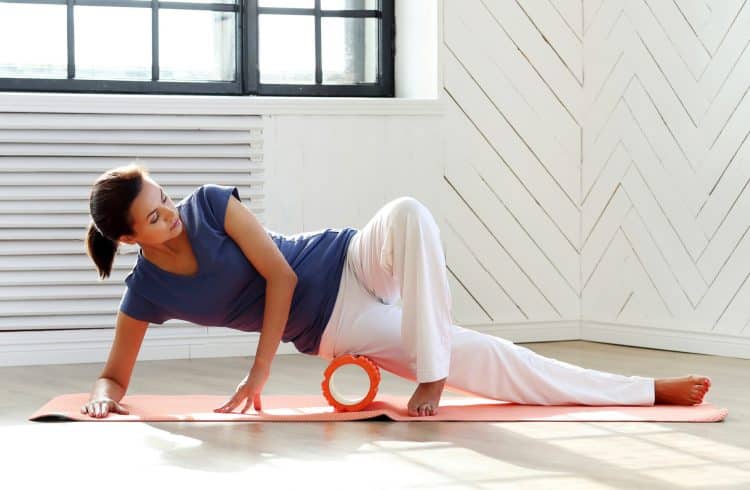
Steps:
- Lie on your front or back so the area you want to treat is in contact with the roller.
- Using your body weight to press down, roll up and down the affected area. Continue for 1-2 minutes or until any tension starts to ease.
- Repeat on any and all affected areas
Benefits:
- A type of self-massage that can help ease muscle tension.
- Once you have a roller, you can perform this treatment in your own home whenever you wish.
- Improves muscle tissue quality, increases blood flow, and eases aches and pains.
Tips:
- Don’t go too hard too soon; over-zealous foam rolling can lead to bruises.
- Warm up the area to be treated with some easy movements and light stretches.
- Start with a soft form roller, progressing to a more rigid model after a few months as your tolerance improves.
15. Walking
Muscles targeted: Quadriceps, hamstrings, gluteus maximus, abductors, adductors, gastrocnemius, soleus, etc.
Our last leg pain exercise is hardly an exercise at all and something that most people take for granted. However, regular walking is one of the best ways to prevent and treat leg pain. Walking provides a gentle stretch for your major leg muscles, increases blood flow, and eases the aches and pains of prolonged sitting. If your legs hurt, you should try to walk more and sit less!
Steps:
- Go for a walk!
- Walk for a few minutes many times a day or enjoy a longer walk whenever you have time.
- Try to walk instead or drive or ride whenever possible, e.g., for journeys of less than a mile.
- Look for opportunities to walk more, e.g., by taking the stairs and not the elevator, leaving your car a little further from your destination, and walking instead of driving your kids to school.
Benefits:
- Walking can help you lose weight and improve your fitness.
- Walking is good for the environment.
- Walking provides a great way to relax and unplug from technology, so it’s an excellent stress-buster.
Tips:
- Keep track of your walking using a smartphone app and try to clock up about 10,000 steps per day.
- Wear comfortable shoes and socks to prevent blisters.
- Look for ways to walk more during your day.
Related: Stretching Archives
FAQs
Do you have a question about exercises and stretches for leg pain? No problem, because we’ve got the answers!
1. How often should I perform the recommended leg exercises and stretches to alleviate leg pain effectively?
Depending on the severity and cause of your leg pain, you should be able to do at least some of these exercises every day. After all, many of them should provide quick relief of leg pain. However, if your leg pain is caused by an underlying medical condition, you should always follow the advice of a medical professional.
2. Can you suggest modifications or alternative exercises for individuals with limited mobility or pre-existing leg injuries?
Because the aim of these exercises and stretches is to ease your pain, you should avoid performing anything that makes your pain worse. Pick exercises that are comfortable and convenient to perform and provide the best results for your efforts.
You don’t need to do all these exercises and stretches. Instead, choose a few and work on getting the most from each one. As the saying goes, do more, better.
3. Do you recommend any specific warm-up routines before engaging in these leg exercises to prevent further pain or injury?
A light warm-up consisting of some easy cardio may be helpful before doing some of these exercises. However, you can also just gently ease into your chosen exercise to avoid further pain and prevent injuries. If your muscles start to burn or shake, you have probably gone too far too fast. Ease off and then try again.
Related – Warm Up: The 12 Best Leg Stretches Before a Workout
4. Which exercises or stretches in the article would be most beneficial for addressing calf pain after running?
Calf pain after running is a common and frustrating problem. Possible solutions include:
- Calf stretches
- Foam rolling
- Inversion
- Alternating cold and warm compresses
You may also benefit from strengthening your calves, as weakness could mean your muscles are working harder than they need to, which can also be a source of pain.
5. Are there any other lifestyle changes or supplementary therapies that can complement the pain relief process for leg discomfort?
Additional things that may prevent/alleviate leg pain include:
- Losing weight – being heavy puts more stress on your bones, joints, muscles, tendons, and ligaments.
- Stay hydrated – dehydration is a leading cause of cramps.
- Eat more vegetables and fruits – plant foods contain the vitamins and minerals your body needs to control nerve impulses and muscle contractions.
- Sit less and move more – sedentarism is a leading cause of leg pain.
- Get a massage – massage can help alleviate many of the causes of leg pain.
- Seek professional advice – speak to your doctor about persistent or severe leg pain.
6. Is it better to perform leg exercises and stretches before or after my regular workout routine for optimal pain relief and flexibility?
In general, strengthening exercises such as glute bridges and calf raises are best performed before your regular workout routine, whereas stretching and relaxation exercises are best done afterward. However, this is not a hard, fast rule, and you may find the reverse is true. For example, foam rolling before your workout may improve your range of motion and make your movements more comfortable.
Try both approaches and see what works best for you.
7. I have a busy schedule and limited time for exercise. Which one or two leg exercises and stretches from the article would you recommend as the most effective for relieving leg pain?
None of these exercises should take long, so even the busiest person should be able to find 10-15 minutes a day to alleviate and prevent leg pain.
That said, in terms of bang for your buck, foam rolling is probably your best choice. Combined with plenty of walking, this will prevent and help ease most forms of muscular leg pain. Toss in some Asian squats, and you have the perfect triumvirate of leg-pain-relieving leg exercises.
Wrapping Up
Leg pain is no one’s idea of fun. It can make sitting, walking, and even sleeping uncomfortable. It can even be debilitating and prevent you from exercising. Of course, some causes of leg pain are more serious than others, and you should always seek medical advice if your pain is persistent or severe.
That said, the body has a remarkable capacity for self-healing, and there are several exercises and stretches you can do that will help or prevent leg pain.
Pick a couple of exercises from the 15 listed above and see how they affect your pain. If they work, then stick with them. However, if they’re ineffective, try another. With a little trial and error, you should be able to develop the perfect prescription for less leg pain.

